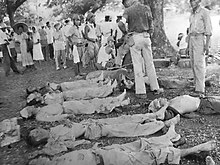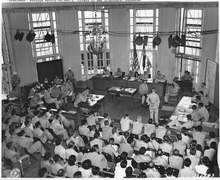
The Philippine Scouts (Filipino: Maghahanap ng Pilipinas/Hukbong Maghahanap ng Pilipinas) was a military organization of the United States Army from 1901 until after the end of World War II. These troops were generally Filipinos and Filipino-Americans assigned to the United States Army Philippine Department, under the command of American commissioned officers (though a handful of Filipino Americans received commissions from the United States Military Academy). Philippine Scout units were given the suffix "(PS)", to distinguish them from other U.S. Army units.
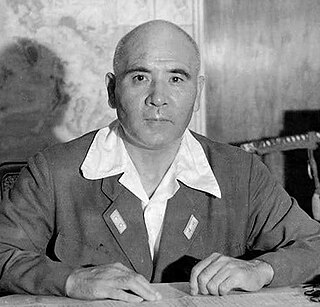
Masaharu Homma was a lieutenant general in the Imperial Japanese Army during World War II. Homma commanded the Japanese 14th Army, which invaded the Philippines and perpetrated the Bataan Death March. After the war, Homma was convicted of war crimes relating to the actions of troops under his direct command and executed by firing squad on April 3, 1946.

The Philippines campaign, also known as the Battle of the Philippines or the Fall of the Philippines, was the invasion of the American territory of the Philippines by the Empire of Japan and the defense of the islands by United States and the Philippine Armies during World War II.

The Battle of Corregidor, fought on 5–6 May 1942, was the culmination of the Japanese campaign for the conquest of the Commonwealth of the Philippines during World War II.

The Battle of Bataan was fought by the United States and the Philippine Commonwealth against Japan during World War II. The battle represented the most intense phase of the Japanese invasion of the Philippines during World War II. In January 1942, forces of the Imperial Japanese Army and Navy invaded Luzon along with several islands in the Philippine Archipelago after the bombing of the American naval base at Pearl Harbor.

The Raid at Cabanatuan, also known as the Great Raid, was a rescue of Allied prisoners of war (POWs) and civilians from a Japanese camp near Cabanatuan, Nueva Ecija, Philippines. On January 30, 1945, during World War II, United States Army Rangers, Alamo Scouts and Filipino guerrillas liberated more than 500 from the POW camp.

Colonel Thomas F. Breslin (1885–1942) was a civil engineer and a civilian contractor for the United States Army. He was pinned as a Colonel at the outbreak of the Battle of the Philippines and died during the Bataan Death March, the brutal POW march in the aftermath of the Battle of Bataan.
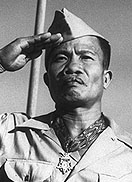
Jose Cabalfin Calugas was a member of the Philippine Scouts during World War II. He received the Medal of Honor for actions during the Battle of Bataan.

Camp O'Donnell is a current military base and former United States military reservation in the Philippines located on Luzon island in the municipality of Capas in Tarlac. It housed the Philippine Army's newly created 71st Division and after the Americans' return, a United States Army camp. During World War II, the reservation was used as a prisoner-of-war camp for Filipino and American soldiers captured by Japan during its successful invasion of the Philippines. About 60,000 Filipino and 9,000 Americans were housed at the camp. During the few months in 1942 that Camp O'Donnell was used as a prisoner-of-war camp, about 20,000 Filipinos and 1,500 Americans died there of disease, starvation, neglect, and brutality.

The Japanese occupation of the Philippines occurred between 1942 and 1945, when the Japanese Empire occupied the Commonwealth of the Philippines during World War II.
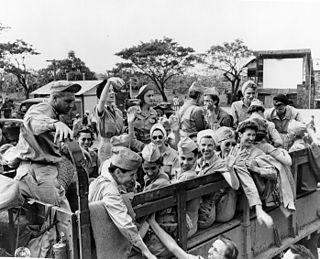
The Angels of Bataan were the members of the United States Army Nurse Corps and the United States Navy Nurse Corps who were stationed in the Philippines at the outset of the Pacific War and served during the Battle of the Philippines (1941–1942). When Bataan and Corregidor fell, 11 navy nurses, 66 army nurses, and 1 nurse-anesthetist were captured and imprisoned in and around Manila. They continued to serve as a nursing unit while prisoners of war. After years of hardship, they were finally liberated in February 1945.

In the United States, National POW/MIA Recognition Day is observed on the third Friday in September. It honors those who were prisoners of war (POWs) and those who are still missing in action (MIA). It is most associated with those who were POWs during the Vietnam War. National Vietnam War Veterans Day is March 29, the date in 1973 when the last US combat troops departed the Republic of Vietnam.

The Palawan massacre occurred on 14 December 1944, during World War II, near the city of Puerto Princesa in the Philippine province of Palawan. Allied soldiers, imprisoned near the city, were killed by Imperial Japanese soldiers. Only eleven men managed to survive.

The Pantingan River massacre was the mass execution of Filipino and American officers and non-commissioned officers Prisoners-of-War by members of the Imperial Japanese Army during the Bataan Death March on April 12, 1942, in Bagac, Bataan. Several hundred soldiers from the Philippine Commonwealth Army's 1st, 11th, 71st, and 91st Divisions on the march to the north of Mount Samat where the Pantingan River crosses the Pilar-Bagac Road were taken to the riverside. Most of them were hog tied with telephone wire, shot, bayoneted or beheaded by the Imperial Japanese Army.
The Philippine War Crimes Commission was a commission created in late 1945 by General Douglas MacArthur as Supreme Commander of the Allied Powers to investigate the war crimes committed by the Imperial Japanese Army and Imperial Japanese Navy during the invasion, occupation, and liberation of the Philippines. The investigation by the Commission led to the extradition, prosecution, and conviction of Class A, Class B, and Class C defendants in Manila, Tokyo, and other cities in East and Southeast Asia through the International Military Tribunal for the Far East.
The Marine Detachment, Air Warning Service, Philippines (1941–42) was a United States Marine Corps ground based early-warning radar detachment that provided long range detection and rudimentary fighter direction against Japanese air raids during the Japanese invasion of the Philippines in the early days of World War II. It was the first Marine Corps early warning detachment to participate in combat operations.

Naval Base Manila, Naval Air Base Manila was a major United States Navy base south of the City of Manila, on Luzon Island in the Philippines. Some of the bases dates back to 1898, the end of the Spanish–American War. Starting in 1938 civilian contractors were used to build new facilities in Manila to prepare for World War II. Work stopped on December 23, 1941, when Manila was declared not defendable against the Empire of Japan southward advance, which took over the city on January 2, 1942, after the US declared it an open city. US Navy construction and repair started in March 1945 with the taking of Manila in the costly Battle of Manila ending on March 2, 1945. Naval Base Manila supported the Pacific War and remained a major US Naval Advance Base until its closure in 1971.

The Philippines being one of the major theaters of World War II, has commissioned a number of monuments, cemeteries memorials, preserved relics, and established private and public museums, as well as National Shrines, to commemorate battles and events during the invasion, occupation, and liberation of the country. The United States and Japan also has established a number of memorials in the country.
United States Forces in the Philippines (USFIP) is a unified command in the Philippines during World War II. It was the successor to the United States Army Forces in the Far East (USAFFE) which General Douglas MacArthur commanded. He moved to Australia as he evacuated as ordered by President Roosevelt in March 1942. The command only lasted two months as it surrendered by Lieutenant General Jonathan M. Wainwright to Lieutenant General Homma Masaharu commander of 14th Army of the Imperial Japanese Army.






